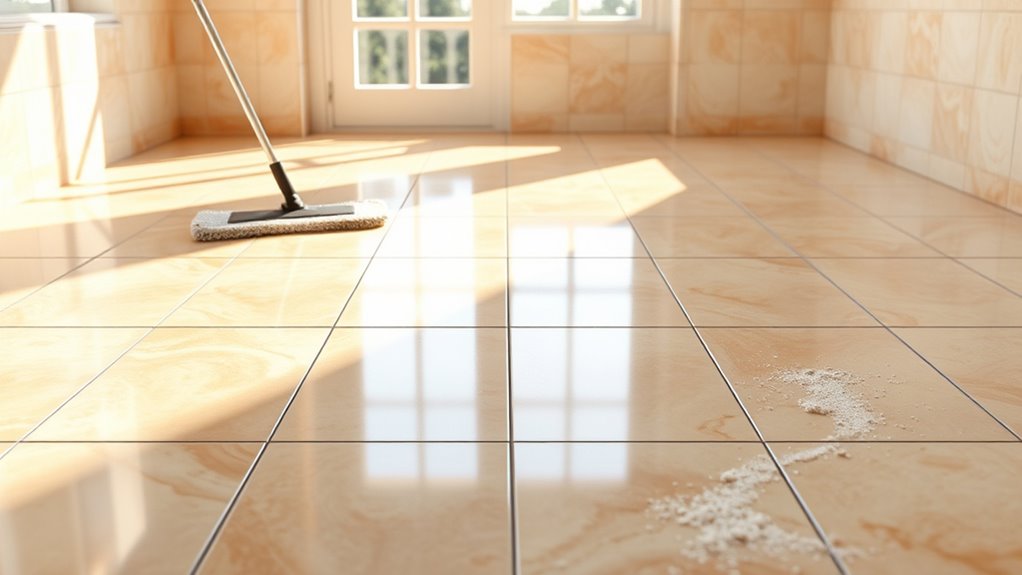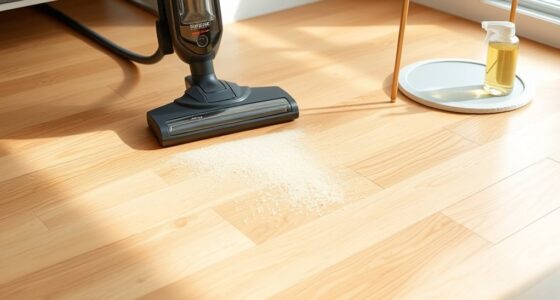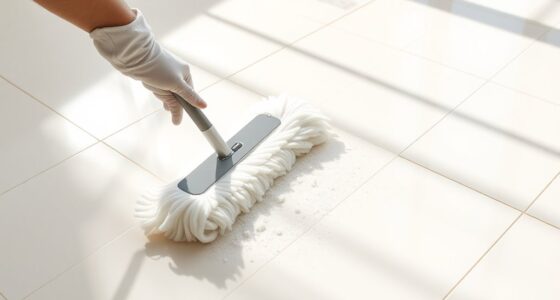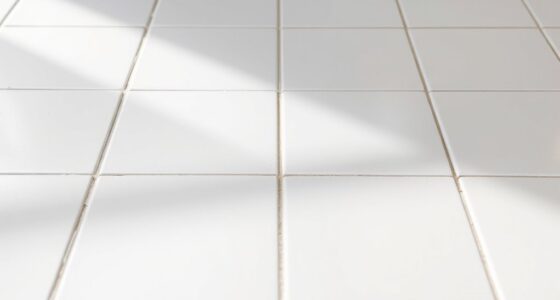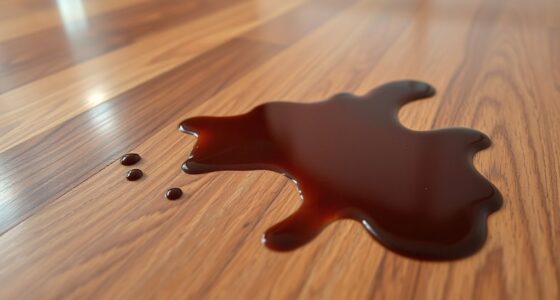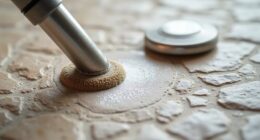For tile floors, dry mopping is best for quick dusting and debris removal, especially in high-traffic areas, helping prevent scratches and keeping surfaces looking clean. Damp mopping works better for stubborn stains, grime, and routine deep cleaning, restoring shine without damaging grout or tiles. Use dry mops regularly and switch to damp mops occasionally for thorough cleaning. Keep in mind the right method for each situation to protect your floors and maintain their appearance—more tips can help you do just that.
Key Takeaways
- Use a dry mop for routine dusting and debris removal, especially in high-traffic areas.
- Damp mopping is best for deep cleaning stubborn stains, grime, and maintaining tile shine.
- Always dry mop first to remove loose dirt before damp mopping to prevent dirt from grinding into tiles.
- Avoid oversaturating tiles with damp mops to prevent damage to grout and underlying surfaces.
- Switch between dry and damp mops based on cleaning needs: dry for daily maintenance, damp for deeper cleaning.
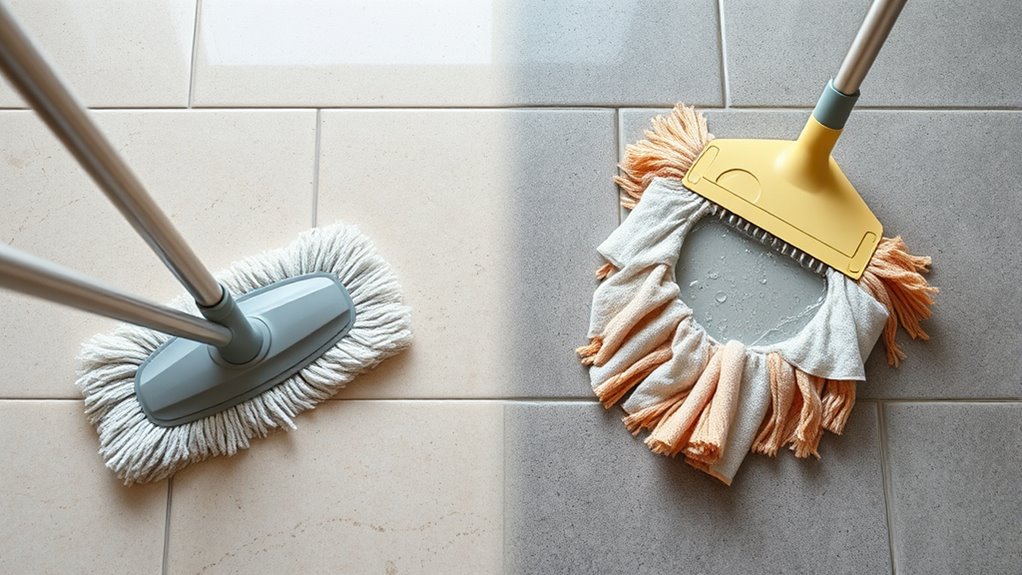
When it comes to mopping techniques, a dry mop is perfect for regular dusting and removing loose debris. It’s quick, easy, and helps prevent scratches that can happen if dirt particles get ground into the surface during cleaning. You might use a microfiber dust mop or a soft broom to sweep away dirt before moving on to deeper cleaning. This step is vital because it prevents dirt from spreading around when you mop with liquids later. If you prefer a dry mop, make sure it’s clean and free of lint to avoid leaving fibers on your tile.
Dry mops are ideal for dusting and removing debris before deeper cleaning.
Damp mopping, on the other hand, is better for cleaning stubborn stains, sticky spots, or built-up grime. When you opt for a damp mop, you should use the right cleaning solutions—mild, pH-neutral cleaners are usually best for tile because they won’t damage the surface or grout. Dilute your cleaning solutions properly and avoid overly harsh chemicals, which can cause discoloration or deterioration over time. To do this efficiently, dip your mop into the cleaning solution, then wring it out thoroughly so it’s damp but not dripping. Excess moisture can seep into grout lines and cause mold or weaken the adhesive. A damp mop works well for routine deep cleans because it lifts dirt from the surface without oversaturating the tile. Additionally, appropriate cleaning methods can extend the lifespan of your tiles and maintain their appearance longer.
Knowing when to switch between dry and damp mopping is key. Use a dry mop regularly to maintain a dust-free surface, especially in high-traffic areas. Reserve damp mopping for when floors look dull or have visible spots and stains. If you’re dealing with sticky spots or footprints, damp mopping with a suitable cleaning solution will restore shine and cleanliness. Be mindful not to leave puddles or excessive moisture, as this can lead to damage over time. Always rinse your mop frequently and change the cleaning solution if it becomes dirty or overly soiled.
Frequently Asked Questions
Can I Use Vinegar to Clean Tile Floors?
You can use vinegar cleaning to maintain your tile floors, but do so cautiously. Vinegar is effective for removing grime and mineral buildup, making it a good choice for tile maintenance. However, avoid using undiluted vinegar or applying it too frequently, especially on natural stone tiles like marble or granite, as it can damage the surface. Always dilute vinegar with water and test in a small area first.
How Often Should I Dry Mop My Tile Floors?
Did you know that a proper maintenance routine can extend your tile floor’s lifespan by up to 50%? You should dry mop your tile floors at least once a week to prevent dirt buildup and maintain their shine. Regular mopping frequency keeps your floors looking new and reduces grime accumulation. Incorporate dry mopping into your routine, especially in high-traffic areas, to keep your tiles spotless and well-maintained.
Is Steam Mopping Safe for All Tile Types?
Steam mopping is generally safe for most tile types, but you should check if your tiles are sealed. Steam cleaning can effectively remove dirt without harsh chemicals, but unsealed tiles may absorb moisture, leading to damage. Always verify your tiles are properly sealed to prevent water infiltration. If unsure, test a small area first, and consider resealing tiles regularly for added protection and longevity.
What Cleaning Products Are Best for Sensitive Tiles?
Did you know that using the wrong cleaner can damage 30% of tile surfaces? For sensitive tiles, opt for pH balanced cleaners or DIY tile solutions that are gentle yet effective. These products prevent etching and discoloration, ensuring your tiles stay pristine. Always check labels to avoid harsh chemicals and test new solutions in small areas first. Your tiles will thank you for choosing safe, gentle cleaning options.
How Do I Prevent Grout From Staining?
To prevent grout from staining, you should seal it regularly with a high-quality grout sealing product. This creates a protective barrier against spills and dirt. If stains do occur, use stain removal techniques like baking soda paste or a gentle vinegar solution to lift them. Remember, sealing your grout every 6-12 months helps maintain its appearance and prevents future stains.
Conclusion
In the end, choosing between a dry or damp mop isn’t just about cleanliness—it’s about maintaining the beauty of your tile floors. Think of your cleaning method as a brushstroke on a masterpiece; each choice impacts the final image. A dry mop keeps dirt at bay, while a damp mop banishes grime. Mastering this balance ensures your floors shine like a work of art, proving that sometimes, the simplest choices make the biggest difference.
